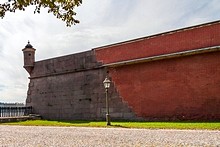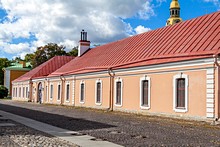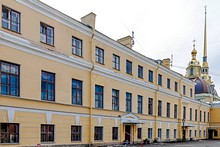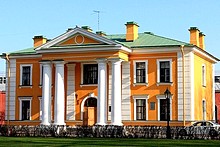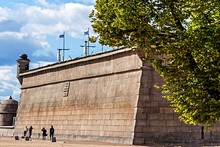Buildings of the Peter and Paul Fortress
The Peter and Paul Fortress includes several buildings constructed in wide range of architectural styles and for a huge variety of different purposes, ranging from the grim prisons of the Trubetskoy Bastion to the Grand Ducal Mausoleum, built to house the remains of the Romanov family. This photographic tour provides a brief introduction to the varied architectural treasures of the Peter and Paul Fortress. The Peter and Paul Fortress includes several buildings constructed in wide range of architectural styles and for a huge variety of different purposes, ranging from the grim prisons of the Trubetskoy Bastion to the Grand Ducal Mausoleum, built to house the remains of the Romanov family. This photographic tour provides a brief introduction to the varied architectural treasures of the Peter and Paul Fortress.
The entrance to the Peter and Paul Fortress is through the gates of the Ioannovskiy Ravelin, one of two triangular defensive structures that bookend the fortress to the east and west.
The ceremonial entrance to the fortress, the Petrovskiy Gates are one of the oldest surviving structures of the fortress, and were built to celebrate victory in the Great Northern War.
An imposing defensive structure named after Peter the Great's mercurial favourite, the Menshikov Bastion once held secret detention and torture cells.
Facing the Neva River at the south-east corner of the Peter and Paul Fortress, the "master's bastion" was constructed under the supervision of Peter the Great and now houses temporary exhibitions.
A baroque building from the mid 18th century that was once the home and workplace for the engineers responsible for constructing and maintaining the fortress defences.
This plain necolassical building has been employed in a variety of functions since it was constructed at the beginning of the 19th century.
Once home to the main treasury of the Russian Empire, this plain building next to the Kronverskaya Curtain Wall went on to house a variety of military departments.
Running west from the Menshikov Bastion, this section of defensive wall was once used to hold the leaders of the Decembrist Uprising.
Built at the beginning of the 20th century to house the tombs of junior members of the Romanov family, this elegant building is attached to the Ss. Peter and Paul Cathedral.
This striking modern sculpture is supposed to give a realistic impression of the great Tsar's dimensions, and was placed in front of the Main Guardhouse in 1991.
An elegant neoclassical building dating from the 1740s, the Guardhouse was the headquarters of the fortress guard, and used to hold arrested officers.
Part of the granite-clad defences facing the Neva River, the Nevsky Curtain Wall is notable for its elegant neoclassical gates, and now houses a historic printing workshop.
Projecting south into the Neva River, the Naryshkin Bastion is the point from where the fortress's 12pm cannon is fired daily, and where the flagpole flying the fortress flag is located.
Built in the 1740s, this sizeable baroque building once housed the home and offices of the Fortress Commandant. Now it is home to the main collection of the Museum of the History of St. Petersburg.
One of the oldest and most magnificent buildings in the city, this fine baroque cathedral with its distinctive golden spire is the centerpiece of the Peter and Paul Fortress, and probably the greatest work of the Italian architect Domenico Trezzini.
An elegant 18th century pavilion that was built to showcase a small sailboat used by Peter the Great in his youth and awarded the title "Grandfather of the Russian Navy", the boathouse is now used as a ticket office.
This plain 19th century structure is part of the St. Petersburg Mint, and was originally erected as a store for the monetary funds that backed the bills of credit issued by the Imperial court.
Named after one of Peter the Great's closest advisers, who became the first Chancellor of Russia, the Golovkin Bastion dates back to the early 18th century, and was used as a storehouse, as well as containing isolation cells.
The only part of the fortress curtain walls to retain their original 18th century internal structure, the Nikolskiy Wall and Gate were named after a church to St. Nicholas that once stood nearby.
St. Petersburg's Mint, situated on the square in front of the Peter and Paul Cathedral, dates back to the 1720s, and continues to produce commemorative coins and state awards.
Named for a tutor and close advisor of Peter the Great, the Zotov Bastion once housed the offices of the Secret Chancellery, the Tsar's feared secret police force.
Forming the western section of the fortress's defenses, facing Vasilievskiy Island, this part of the curtain wall once housed the barracks of the prison guards from the Trubetskoy Bastion.
Once of the most famous buildings in the Peter and Paul Fortress, this section of the outer defenses was used to hold prominent political prisoners in the 19th century. It now contains a museum.
Another building that was used as part of the fortress prison, the Alexeevskiy Ravelin housed many prominent inmates, including Fyodor Dostoevsky.




